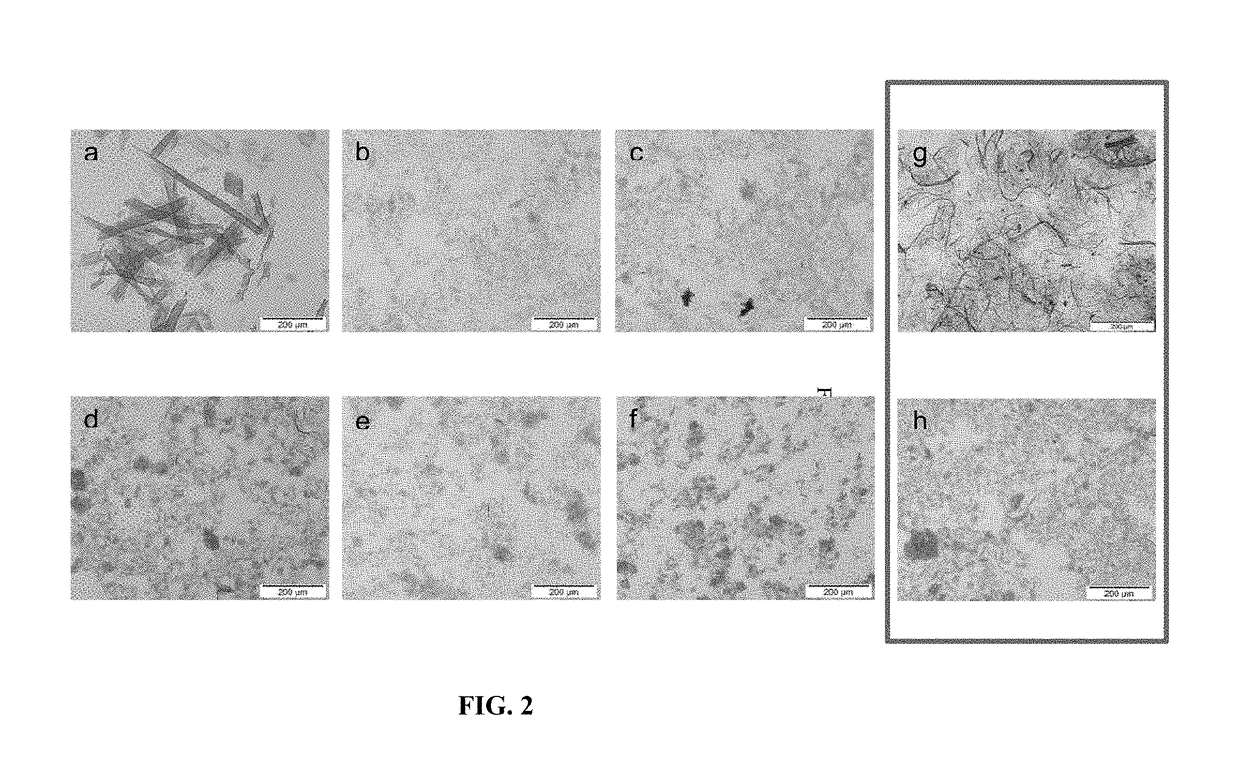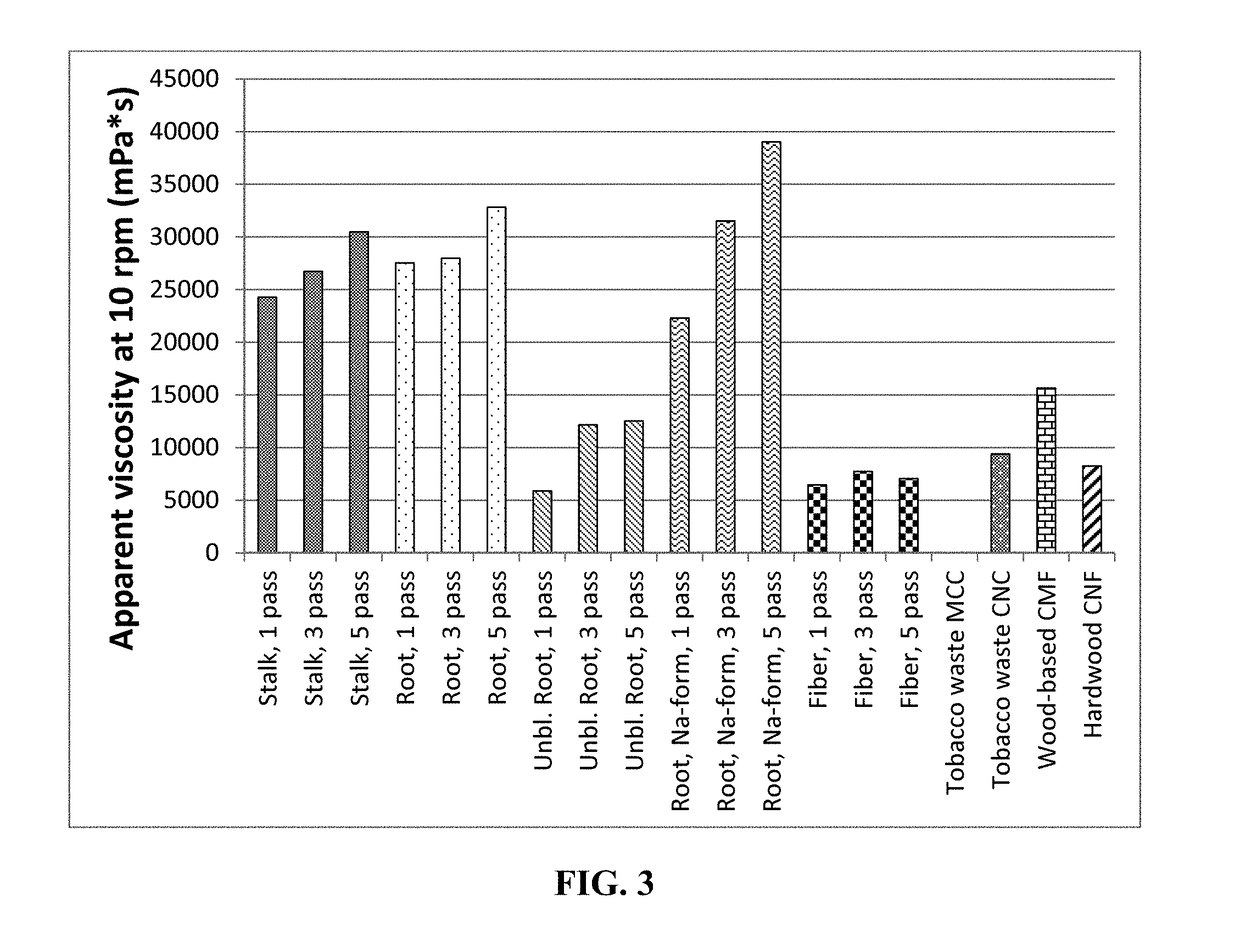Tobacco-derived nanocellulose material
a technology of nanocellulose and tobacco, which is applied in the direction of cellulose treatment using microorganisms/enzymes, tobacco, applications, etc., can solve the problems of time and energy consumption in the production of cellulose nanomaterials, and achieve the effect of reducing the number of fibrillation cycles and reducing the amount of energy
- Summary
- Abstract
- Description
- Claims
- Application Information
AI Technical Summary
Benefits of technology
Problems solved by technology
Method used
Image
Examples
example 1
Making Tobacco Pulp
[0133]Tobacco pulp is prepared according to the methods disclosed in U.S. Patent Application No. 2016 / 0208440 to Byrd, Jr et al. and U.S. Pat. No. 9,339,058 to Byrd, Jr et al., which are incorporated by reference in their entireties. All pulping equipment is typically made of stainless steel. The cooking devices are either cylindrical or spherical pressure vessels. Pressure screens can be used to remove large particles and side-hill atmospheric screens can be used to remove fines.
[0134]The bleaching equipment is atmospheric cylindrical tanks and is typically made of Hastelloy or fiberglass reinforced plastics for equipment exposed to bleaches containing chlorine. Stainless steel is typically used for chlorine-free bleaches. The same types of washers can be used to remove bleach from the equipment as is generally used to clean the cooking devices. All of these components can be made by a wide variety of manufacturers such as, but not limited to, Andritz, Metso, GL&...
example 2
on of Nanocellulose Materials
[0158]Cellulose nanofibrils (CNF) are produced using never dried tobacco waste pulps produced as set forth in Example. The fiber slurry is first soaked at 1.7% consistency and dispersed using a high shear Diaf dissolver for 10 minutes at 700 rpm. The suspension is pre-refined in a grinder (Supermasscolloider MKZA10-15J, Masuko Sangyo Co., Japan) at 1500 rpm. The pre-refined fiber suspension is fed into a Microfluidizer M-7115-30. First pass is through the chambers having a diameter of 500 μm and 200 μm. The next four passes are through the 500 μm and 100 μm chambers. The fibrillated samples are produced after 1, 3 and 5 passes and the operating pressure is 1800 bar. The specific energy consumption varies between 4 (one pass) to 25 kWh / kg (five passes). The fiber slurry becomes a viscous gel after the mechanical treatment with a final solid content of 1.6-1.8%.
[0159]Apparent viscosity is measured at 1.5% fixed consistency for a comparison with Brookfield ...
example 3
on of Nanocellulose-Based Film and Application Trials
[0161]Films are made using SUTCO surface treatment technology available from VTT Technical Research Centre of Finland Ltd and described in International Application No. 2014 / 0255688 to Salminen et al., which is hereby incorporated by reference in its entirety. The process is a solution casting type process where a CNF suspension having adequate viscosity is cast on a moving plastic web. The plastic is pre-treated using a plasma device with a predetermined power level. The correct level is tested on a hand sheet scale before trials.
[0162]The CNF containing suspensions are agitated before film making in a high shear mixer. After 60 minutes of mixing, an additive (sorbitol) is added to the mixing vessel and mixing is continued for another 60 minutes. After mixing, air is removed from the suspensions by mixing for 5 minutes in a vacuum. This ensures that no air bubbles are present as the CNF suspension is cast on the support web. Afte...
PUM
| Property | Measurement | Unit |
|---|---|---|
| pressure | aaaaa | aaaaa |
| pressure | aaaaa | aaaaa |
| particle size | aaaaa | aaaaa |
Abstract
Description
Claims
Application Information
 Login to View More
Login to View More - R&D
- Intellectual Property
- Life Sciences
- Materials
- Tech Scout
- Unparalleled Data Quality
- Higher Quality Content
- 60% Fewer Hallucinations
Browse by: Latest US Patents, China's latest patents, Technical Efficacy Thesaurus, Application Domain, Technology Topic, Popular Technical Reports.
© 2025 PatSnap. All rights reserved.Legal|Privacy policy|Modern Slavery Act Transparency Statement|Sitemap|About US| Contact US: help@patsnap.com



